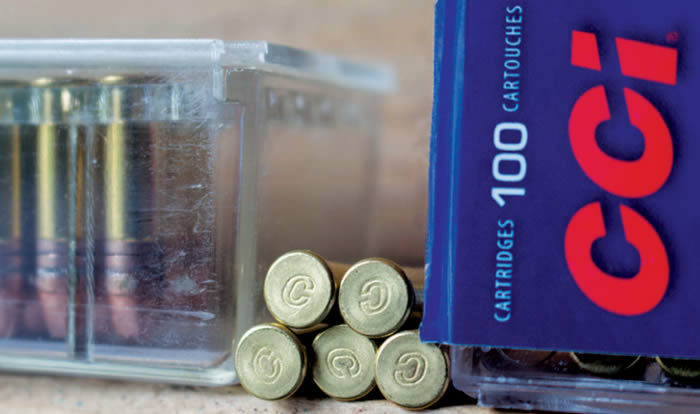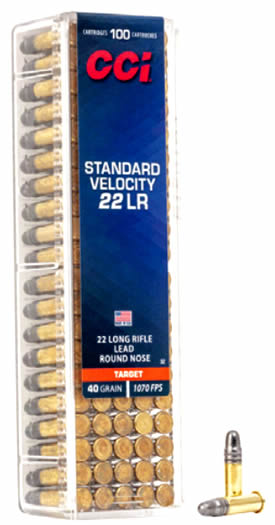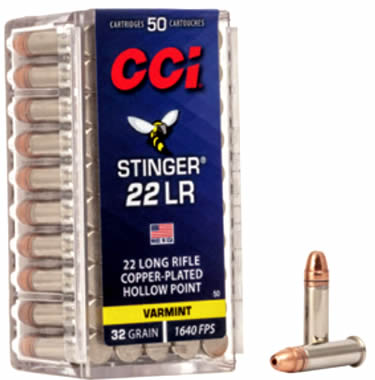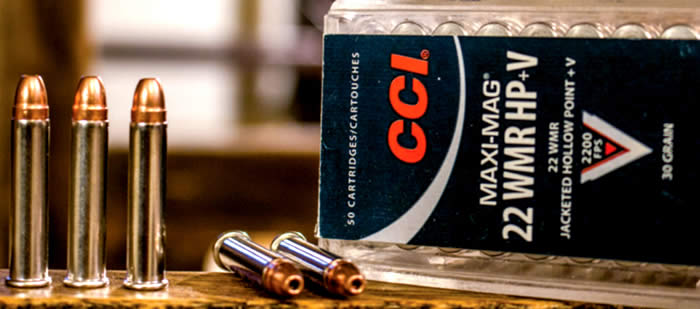Squirrelin Around with CCI

With numerous .22- and .17-Caliber Cartridge lines, ammo company has Bushytail Hunters’ needs covered.
Story by Phil MassaroPhotos by Massaro Media Group
Late August in Kentucky’s Land Between the Lakes – that patch of ground between the confluence of the dammed sections of the Tennessee and Cumberland Rivers – is a special time of year, for it is when squirrel season opens.
Hunting squirrels is a classic American experience, and across the generations it has been a rite of passage for young hunters, as well as a bona fide source of protein for impoverished families.
As a youth, I was privileged to hunt with some folks who grew up during the Depression, when life on a farm was difficult enough to begin with, let alone when coupled with the financial inability to keep any of the animals that were raised for money to keep the farm afloat, and a near-complete lack of deer
to be hunted for meat.

Velocity .22 LR
ammunition
remains among
their top-selling
products. It is
very consistent
and has many
practical
applications.
I remember David Miller, a local farmer who was like a second father to my dad, telling me that he’d be up at first light before school every day in the fall to try and collect at least a couple of squirrels for the family’s dinner. This was hunting out of absolute necessity, and it translated into a fall tradition. My very first game animal taken was a gray squirrel, just a few days after my 14th birthday.
Having saved up the entire summer for a Fox Model B-SE .410-bore side-by-side shotgun, hunting squirrels would make an indelible mark on my youth, carrying over into adulthood. When I was invited to travel to Kentucky to participate in the squirrel opener, along with several other colleagues, I immediately accepted; unlike so many of the deer and other big game hunts we are often invited to
attend, this was completely different. We were encouraged to bring whatever rifle and/or shotgun we liked, and to try some different types of CCI ammunition. While this hunt was already a means of reconnecting with my youth – many fall weekends were spent chasing rabbits and squirrels with my father and maternal grandfather – it also got me thinking about the different types of cartridges and ammunition available to those who seriously pursue the “limb rats.”
August is warm almost anywhere in the northern hemisphere, and Kentucky is no exception. When it’s hot and humid, gray and fox squirrels can be found in the tops of hickory trees – both pignut and shagbark – as well as feasting on acorns and pine cones alike.
In spite of the plentiful vegetation, shots can actually be on the long side, as some of those trees approach 100 feet tall and you might have to back off in order to obtain the shot.
While a shotgun is certainly an effective tool, spitting pellets back onto your dinner plate is no fun at all,
so a rimfire and head shots (as often as is possible) is the course of action for me. And I find that the three most popular rimfires – the .22 Long Rifle, the .22 Winchester Magnum Rimfire and the .17 Hornady Magnum Rimfire – are the three best choices for the job. CCI offers some fantastic ammo for all three, and I’ve picked my personal favorites for each of them.

pleased with this five-shot 50-yard
group from CCI’s Clean-22 ammunition.
.22 LONG RIFLE
Starting with the .22 Long Rifle, we have the oldest and most popular rimfire cartridge of all time. It has been with us since the mid-1880s, and has been the darling of small game hunters and target shooters alike. CCI offers many different loads for the .22 LR, with the most popular being the Standard Velocity load. Using a standard 40-grain round nose lead bullet at a muzzle velocity of 1,070 feet per second, this apparently ho-hum load works just fine on squirrels. It certainly doesn’t require a ton of energy to kill a squirrel, but you do need to be able to put the bullet on target, especially when it is just a squirrel’s head poking out from behind a limb. The lead bullets are known to foul a barrel faster than a jacketed
bullet, but this simple and timeless design still works perfectly.
If that fouling bothers you, look no further than CCI’s Clean-22 line. The rifle I took to Kentucky – a Savage Mark II BRJ topped with a Leupold VX-3HD 4.5-14×40 – absolutely loves the 40-grain polymer-coated Clean-22 (the red-coated model at 1,235 fps), putting five rounds into a group under ½-inch at 50 yards. If you like to get a bit closer, or are in a situation where you want to keep noise to a minimum,
the blue-coated Clean-22 runs subsonic at 1,070 fps, and will cut down your cleaning chores considerably.

Stinger has
long been
a favorite of
the author’s
dad, who
appreciates
the higher
velocity
and flatter
trajectory.
If you really want quiet, grab a box of CCI’s Quiet-22 Semi-Auto. Using a 45-grain lead round nose bullet at the sedate muzzle velocity of 835 fps, this is great for closer shots, yet has the power to cycle the autoloaders. I’ve long relied upon this very quiet load for dispatching garden pests and numerous red squirrels, which will eat holes in the soffits of the barn and make an absolute mess of things.
CCI has long been famous for its Stinger ammo; using a slightly longer cartridge case, yet maintaining the destroy meat on body shots, so keep to the head shots.
Of all of CCI’s .22 LR loads, I really like the classic MiniMag load; this uses a 36-grain jacketed hollow point at a velocity of 1,260 fps and is hell on squirrels. I have found it to be wonderfully accurate, making it a sound choice for longer head shots, and the jacketed construction won’t foul your barrel as quickly as the lead bullets will. It was this load that I chose for the Kentucky squirrel adventure, and it served me very well. Whether it is an early-season squirrel hunt with plenty of vegetation, or a late-winter jaunt through the bare woods, I can always count on CCI Mini Mag ammo.

MiniMag for the .22 LR; it is a great choice for hunters.
.22 WINCHESTER MAGNUM RIMFIRE
The .22 Mag – as it is commonly known – offers an increased case capacity and correlative higher velocity. If the MiniMag represents a great choice for the .22 LR, the MaxiMag delivers for the .22 WMR. Pushing a 40-grain jacketed hollow point to a muzzle velocity of 1,875 fps, the MaxiMag is enough for foxes and coyotes, let alone squirrels. The increase of 600 fps or so will really show up if you try for body
shots on squirrels, destroying what little meat there is to begin with; with the .22 Mag, it should be head shots only. I like the MaxiMag .22 WMR for the varmint hunter who occasionally hunts squirrels.
There is also an FMJ variant of this load, which will certainly be effective for head shots, yet will be less destructive. If you like instantaneous hydraulic shock and the ability to turn the light switch off immediately, look to the 30-grain Hornady V-Max bullet at 2,200 fps. The high velocity and polymer tip add up to explosive performance, and the results of a head shot can be rather gruesome, though extremely effective.

bullets for
the .17 HMR
don’t do it for
you, there is
a correlative
FMJ
load that is
the same
shape and
weight as the
Gamepoint.
17 HORNADY MAGNUM RIMFIRE
In 2002, Hornady – working with both Marlin and Ruger – released the .17 Hornady Magnum Rimfire, or the .17 HMR, as it has come to be known. Created by necking down the .22 WMR to hold bullets of 0.172-inch diameter, this little speed demon has become quite popular over the last two decades.
Will Brantley, our host and guide on our Kentucky squirrel adventure, uses his CZ rifle in .17 HMR to very good effect; the man has the patience of a saint when he knows there’s a gray squirrel “cuttin’ hickories” in a treetop. The cartridge’s precision, flat trajectory and striking power combine to allow Brantley to take a squirrel in the top of the tallest pine or hickory.
CCI’s Game point 20-grain jacketed soft point will handle the muzzle velocity of 2,375 fps, yet when it hits, it hits with authority. You’ll know when you’ve connected on a head shot, as the resounding “whunk” of the squirrel hitting the ground will be heard within seconds. If the damage caused by the expanding soft point is a bit much for you, look to the 20-grain FMJ load; it will print very close to the same point of impact, yet the non-expanding projectile won’t make as much of a mess.
Grab a box of whatever rimfire cartridge tickles your fancy and reconnect with your youth by heading to the squirrel woods. You just might be surprised by how wily the little buggers can be, and you can take your revenge for all the times a gray squirrel sounded like that trophy buck you were waiting for. I know I found myself smiling as I used my dad’s and grandpa’s old trick of hanging your jacket on the far side of the tree to get the squirrel to come around the other side and offer a shot. Just like riding a bicycle.





